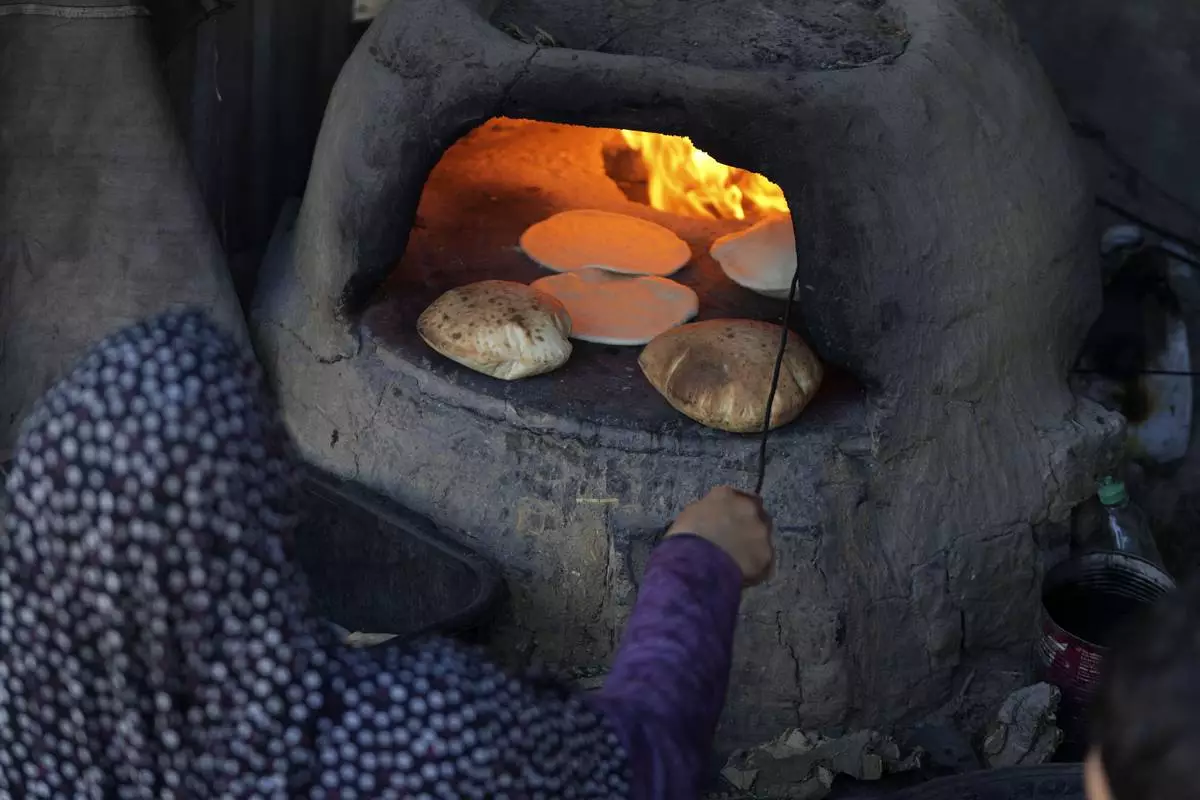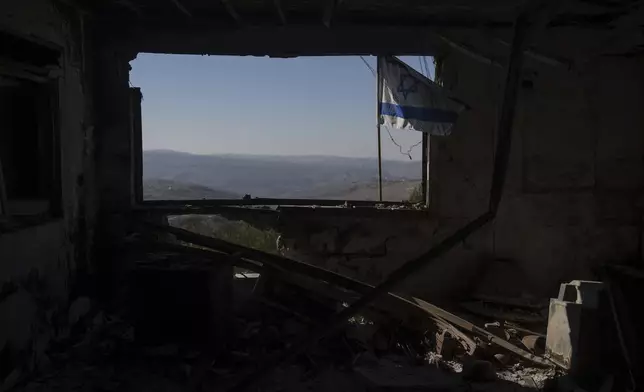JERUSALEM (AP) — Hezbollah fired into a disputed border zone held by Israel on Monday after multiple Israeli strikes inside Lebanon since a ceasefire took hold last week. The militant group said the volley, its first during the truce, was a warning shot in response to what it called repeated Israeli violations.
Israeli leaders threatened to retaliate and within hours, Israel's military carried out a string of strikes in southern Lebanon, including five hits in the al-Tuffah region, Lebanese state media reported. There was no immediate word on casualties or what was struck. Israeli strikes in Lebanon in recent days have killed at least four people and wounded others.
The attacks have further strained the fragile U.S.- and French-brokered ceasefire, which began Wednesday and calls for a 60-day halt in fighting. It aims to end more than a year of war between Hezbollah and Israel that's part of a wider regional conflict sparked by the devastating Israel-Hamas war in Gaza.
Lebanon’s parliament speaker, Nabih Berri, accused Israel of violating the truce more than 50 times in recent days, with strikes, demolition of homes near the border and overflight of drones.
Israel has said its strikes were in response to unspecified Hezbollah violations, and that under the ceasefire deal it reserves the right to retaliate.
The Israeli military said Hezbollah launched two projectiles on Monday toward Mount Dov, a disputed Israeli-held territory known as Shebaa Farms in Lebanon, where the borders of Lebanon, Syria, and Israel meet. Israel said the projectiles fell in open areas and no injuries were reported.
Hezbollah said in a statement that it fired on an Israeli military position in the area as a “defensive and warning response” after what it called “repeated violations” of the ceasefire deal by Israel. It said complaints to mediators tasked with monitoring the ceasefire “were futile in stopping these violations.”
Officials in the United States — which along with France heads a commission meant to monitor adherence to the deal — played down the significance of Israeli strikes. White House national security spokesman John Kirby said, “Largely speaking, the ceasefire is holding.”
“We’ve gone from dozens of strikes down to one a day maybe two a day,” Kirby told reporters, referring to Israeli strikes. “We’re going to keep trying and see what we can do to get it down to zero.”
Israeli Prime Minister Benjamin Netanyahu said the Hezbollah fire was “a serious violation” and vowed, “Israel will respond forcefully.” Defense Minister Israel Katz said the volley “will be met with a harsh response.”
Under the ceasefire deal, Iran-backed Hezbollah has 60 days to withdraw its fighters and infrastructure from southern Lebanon, pulling back north of the Litani River, which is about 30 kilometers (18 miles) from the Israeli-Lebanese border. During that time, Israeli troops are also to withdraw to their side of the border.
On Monday before the Hezbollah fire, Israeli carried out at least four airstrikes and an artillery barrage around southern Lebanon, including a drone strike that killed a person on a motorcycle, according to Lebanese state media. Another strike killed a corporal in the Lebanese security services. The Israeli military said it carried out operations in the south against Hezbollah militants, “thwarting threats to Israeli civilians,” without elaborating.
Another drone strike Monday hit a Lebanese army bulldozer, wounding a soldier, in the northeastern town of Hermel – far north of the Litani River. The Israeli military said it hit military vehicles operating “in the area of a Hezbollah missile manufacturing site.”
The Lebanese army, which stayed on the sidelines of the Israel-Hezbollah fighting, is supposed to deploy additional troops in the south alongside U.N. peacekeepers to ensure Hezbollah’s withdrawal from the area. An Israeli strike on Saturday in the southern Marjayoun area killed two people, according to state media.
In a video statement, Israeli Foreign Minister Gideon Saar said Israel was striking Hezbollah fighters in the south when they are identified or seen attempting to move weapons.
“Their presence south of the Litani River is the most basic violation of the understandings … They must move north immediately,” he said, despite the 60-day period the deal gives for a pullback.
In Gaza, meanwhile, alarm over increasing hunger was growing. The amount of food allowed in by Israel has plunged over the past two months, compounded by a decision Sunday by the U.N. to halt aid deliveries from the main crossing into the territory because of the threat of armed gangs looting convoys.
Experts already warned of famine in the northernmost part of Gaza, which Israeli forces have almost completely isolated since early October.
Muhannad Hadi, the U.N. humanitarian coordinator for the occupied Palestinian Territories, warned on Monday of “severe hunger surging” in central and southern Gaza as well. Speaking at a conference in Cairo aimed at increasing aid, he said more than 1 million people have not received their monthly food rations since July.
Israel’s campaign in Gaza, triggered by Hamas’ Oct 7, 2023 attack on southern Israel, has driven almost the entire population of the territory from their homes. Hundreds of thousands of Palestinians now live in squalid tent camps and reliant on international aid.
In a tent camp in the central Gaza town of Deir al-Balah, Palestinians lined up at makeshift mud ovens trying to buy a few loaves of flatbread for their families.
With the price of flour mounting because of scarcity, the bakers — women displaced from further north — said they could bake less bread, and families could afford far less.
“They divide them to their children, one loaf every day,” said Wafaa al-Attar, who was selling bread she made in a clay oven.
A distant relative also selling bread, Enayat al-Attar, said some people cut up a single piece of flatbread among themselves. “Flour is running out for everyone,” she said.
The Israeli military said it allowed 40 trucks carrying 600 tons of flour for the World Food Program to enter the southern Gaza Strip on Sunday night, as well as 16 other food trucks.
Israel has said it is working to increase the flow of aid. November saw an increase in the average number of humanitarian trucks it let into Gaza, up to 77 daily from 57 the month before, according to official Israeli figures.
But the levels are still nearly the lowest of the entire 15-month war. And the U.N. says less than half of that actually reaches Palestinians because Israeli military restrictions, fighting and robberies make it too dangerous to deliver the aid.
On Sunday, the U.N. agency for Palestinian refugees, known as UNRWA, said it is halting aid deliveries through Kerem Shalom, the main artery for aid, because of repeated robberies. It blamed the breakdown of law and order in large part on Israeli policies.
Abou AlJoud reported from Beirut. AP correspondent Fatma Khalid contributed from Cairo.
Follow AP’s war coverage at https://apnews.com/hub/mideast-wars

Burned-out cars and buildings from Hezbollah rockets are seen in the agricultural settlement of Avivim, near the Lebanese border in the Upper Galilee, Israel, on Monday Dec. 2, 2024. Despite the ceasefire with Hezbollah, Israelis remain wary of returning to the north. (AP Photo/Ohad Zwigenberg)

A view of Lebanese village through a window of a damaged house that was hit by a rocket fired from Lebanon, in the Kibbutz Manara, located in the upper Galilee, northern Israel, Monday Dec. 2, 2024. (AP Photo/Ohad Zwigenberg)

A Palestinian woman sorts through fresh bread amid dire food shortages in Deir al-Balah, Gaza Strip, Monday, Dec. 2, 2024. (AP Photo/Abdel Kareem Hana)

A Palestinian boy carries a tray of baked goods from a clay oven amid dire food shortages in Deir al-Balah, Gaza Strip, Monday, Dec. 2, 2024. (AP Photo/Abdel Kareem Hana)

A Palestinian woman bakes bread in a clay oven amid dire food shortages in Deir al-Balah, Gaza Strip, Monday, Dec. 2, 2024. (AP Photo/Abdel Kareem Hana)

Destroyed buildings in an area of the village of Kfar Kila in southern Lebanon, located next to the Israeli-Lebanese border, as seen from northern Israel, Sunday, Dec. 1, 2024. (AP Photo/Leo Correa)

A wall marks the Israeli-Lebanese border near the village of Odaisseh in southern Lebanon, as seen from northern Israel, Sunday, Dec. 1, 2024. (AP Photo/Leo Correa)

Israeli soldiers patrol the perimeter of the agricultural settlement of Avivim, next to the Lebanese border in upper Galilee, Israel, Monday Dec. 2, 2024. (AP Photo/Ohad Zwigenberg)




















